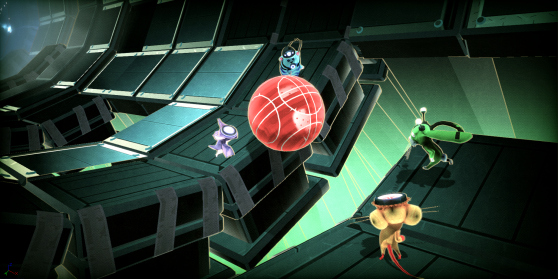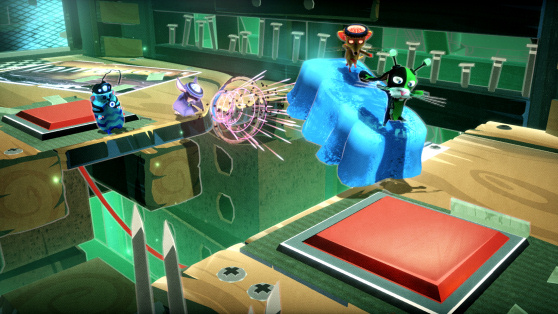The feeling of being an experiment running through a maze is a familiar one for puzzle gamers. Being cast as a test subject fits the nature of the genre, one that essentially scuttles the player from walled-off room to walled-off room to flip switches and progress. Spearhead Games’ Tiny Brains — a bargain priced download available on PS4 December 3rd, with a launch on PC in mid-December and PS3 early next year — takes the notion to the logical next step, casting gamers as a collection of colorful creatures with enhanced mental abilities before depositing them in a puzzle-platforming gauntlet. While swapping between abilities is a blast, particularly with three other players, the short campaign and tacked-on unlockables make this an expensive experiment.
What You’ll Like

Your powers are a lot of fun to mess around with
Whatever went on in the experiments that led to the four playable critters in Tiny Brains was worth it. The spread of creature abilities feels limited at first, but the design of the puzzle and challenge rooms healthily encourages mixing between them in the hunt for solutions. A bat that can push objects away, a rabbit that can pull things toward it, a hamster that can create ice platforms, and a rat that can instantly trade places with an object or creature all serve a distinct and necessary purpose towards finding your way to the next room. Flinging creatures across the room on ice blocks and successfully teleporting a battery through a barred fence lends a definite feeling of satisfaction, no matter how many times you perform the action.
June 5th: The AI Audit in NYC
Join us next week in NYC to engage with top executive leaders, delving into strategies for auditing AI models to ensure fairness, optimal performance, and ethical compliance across diverse organizations. Secure your attendance for this exclusive invite-only event.
The story campaign can be played with anywhere between 1-4 players, and a tap of the R2 button swaps out any missing creatures in the group. The game’s structure is lenient enough to occasionally allow for multiple solutions depending on the amount of creatures in-play. Some of these solutions feel like cheating, bypassing certain buttons or steps in the more telegraphed puzzle-solving process, but it’s not enough to diminish the enjoyment factor. Playing solo comes with a particularly hectic feel, swapping rapidly between creatures in the later stages is the closest the game gets to being a significant challenge for anyone above the game’s E10+ age range.
Gameplay variety keeps the pace constant
While your objective is ultimately to either push a button or insert a battery into a socket, Tiny Brains makes the most of the journey towards the goal. Chapters are divided into three challenge categories: a one-screen puzzle room with a button to push and/or battery to insert, guiding a ball through collapsing floor tiles and twisting bridges, and defending a little pink chicken from enemies. The pattern doesn’t change from chapter to chapter, but the challenges definitely do have a tangible, rising scale to their complexity. New components like machine presses that block certain moves in a puzzle room or tiles that are lit on fire during defense challenges are consistently introduced and seamlessly build on top of existing structure.
Challenge rooms are a nice reward for finishing the story

Beating Tiny Brains’ story campaign and finding enough cheese wedge collectibles unlocks a handful of new features, including a small collection of additional challenges. Separated into individual puzzle, ball, or combat rooms, these diversions are enjoyable little snacks that can be indulged in short, largely repeatable bursts. Most can be finished in minutes or less, and immediately feed time and enemy death count to the leaderboards. The total amount of unlocked content doesn’t have a lot to contribute to extended replay value, but enough challenges have an addictive, “one more go!” vibe to justify at least a few more tries to that higher score threshold.
Tiny Soccer is chaotic bliss
Tiny Soccer, a multiplayer 2-on-2 mini-game of goal swapping with all powers available to every player, is by far the most fun to be had with the game as a whole. Each session is more of a mosh pit of friendly fire and rapid telekinesis than a straightforward march to the goal, but the monitoring of each player’s energy meter insures against a lot of constant ability spamming. Cancelling out your opponent’s progress with a well-timed teleport across the field is a ridiculously addictive play. The ball did get stuck in the environment during one of our matches, effectively ending it prematurely, but the sessions are short enough where a quick restart is an agreeable solution.
What You Won’t Like
The story tries, and fails, to be funny
It’s hard to say exactly who Tiny Brains’ many attempts at humor are directed toward. The rating and difficulty curve would indicate a focus largely on children, but there are more than enough blatant nods to adult topics to make it all seemed geared towards all ages. One minute, the scientist will be characterizing the creatures’ intelligence as “a three-year old human … no, a two-year old human Russian,” and during the next, you can dial a phone sex hotline rife with science puns. The result is a mess of failed witticisms and painfully strained interplay between a scientist and his motherly A.I. The writers also seemed to find chickens, and eating chicken, to be inherently funny for some unexplained reason. A rare joke does manage to draw out a chuckle or two, but most of the time the gags bear the feeling of a writer trying far too hard.
An uninteresting, overly bright presentation
A lot of things shine in laboratories, but that’s no excuse for how bright some of the levels in Tiny Brains can be. Especially in the earlier sections of the story campaign, monitors and other shiny apparatuses take up too much on-screen real estate, and are more likely to blind players than provide ambient contrast. For a budget-priced title, environments and character models are solid if a bit blocky, but the game often feels more concerned with showing a lumbering giant scientist in the background than making the player characters coherent in the foreground. Fire, liquid, and lighting effects can occasionally look impressive — especially during the ball guiding challenges — but nothing about the game’s visuals stands out as worth remembering.
There isn’t enough here to justify the price tag
The spread of what’s available in Tiny Brains, even factoring in unlockable content, simply does not add up to $20. Most of the modes unlocked by completing the story campaign (lasting around 3 hours for the average puzzle game player) are re-purposed versions of the same puzzle and level structure. Turning off friendly fire for one mode (where the avatars are now tiny humans for no reason) doesn’t fit nearly as well in the campaign as it does in Tiny Soccer, and giving players a single life with a new character does little for all but the most masochistic of players. The same cutscenes and puzzle rooms are repeated ad nauseam throughout the entirety of most of the game’s additional modes, making a lot of it redundant, especially with players having just gone through the story to unlock it all. It all stinks of obvious, last-minute efforts to extend shelf life.
Conclusion
Trading powers with scientifically enhanced critters is a ton of fun across Tiny Brains’ various puzzle rooms and combat arenas. But once the brief story campaign has been completed, there is little reason to play beyond the extra half-hour of unlocked challenges and Tiny Soccer matches. Some players will be drawn in again to compete for higher positions on the leaderboard, but it’s hard to stomach the game’s attempts at humor once, let alone for multiple playthroughs. If it came out at half the asking price, there would be little to dissuade a purchase, especially for friends eager for some genuinely engaging four-person co-op. Those not chomping at the bit for simultaneous puzzle-solving, however, should wait for the inevitable discount.
Score: 70/100


